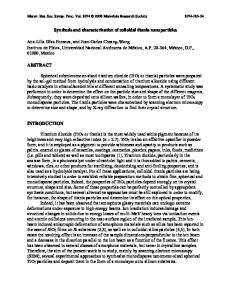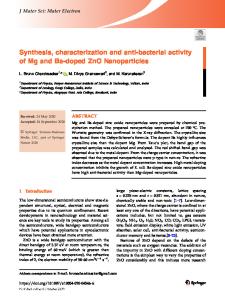Synthesis and Characterization of ZnO Nanoparticles
- PDF / 143,437 Bytes
- 5 Pages / 612 x 792 pts (letter) Page_size
- 108 Downloads / 374 Views
B2.27.1
Synthesis and Characterization of ZnO Nanoparticles
I. U. Abhulimen1, X. B. Chen2, J. L. Morrison 2, V. K. Rangari3, L. Bergman2, and K. Das1 1. Department of Electrical Engineering, Tuskegee University, Tuskegee, AL 36088. USA. 2. Department of Physics, University of Idaho, Moscow, ID 83844-0903. USA. 3. Center for Advanced Materials, Tuskegee University, Tuskegee, AL 36088.USA.
ABSTRACT
Nanoparticles of ZnO were synthesized using a sonochemical technique. Sonochemistry arises from an acoustic cavitation phenomenon, that is, the formation, growth and implosive collapse of bubbles in a liquid medium. The ultraviolet photoluminescence (PL) studies of the samples showed a strong PL intensity and a significant blue shift relative to the PL of the bulk. Shifts up to 70 meV were observed and attributed to a confinement effect. Scanning electron microscopy indicated roughly spherical particles, ~160 nm in diameter. However, nano-platelets and rods were observed in transmission electron micrographs. Preliminary electrical measurements indicated a highly resistive nature of the nanoparticulate material.
INTRODUCTION
Nanoparticles of semiconducting materials are of great interest in modern electronics for the fabrication of sensors, nanoscale logic/memory devices, nanomechanical systems and optoelectronic components. Wide band semiconductors are of particular of interest for their potential applications for the fabrication of high-frequency and optoelectronic devices. Zinc oxide is a direct wide bandgap (3.37 eV) semiconductor that has a high chemical and physical stability. It has an exciton binding energy of about 60 meV [1], high optical gain of 300 cm-1, approximately three times higher than that of GaN [2]. Nanoparticles of ZnO have been reported to be suitable for passive electronic components, such as capacitors, varistors, photoprinting and electrophotography due to low levels of heavy metal impurities. In the past, various techniques have been used for preparation of zinc oxide nanoparticles, such as conventional ceramic fabrication, sol-gel method, reaction spray pyrolysis, use of powders produced during urea production, hydrolysis of bis(acety1 acetonato)-zinc (II), and wet chemical synthesis [3]. In this paper, we report the synthesis of ZnO nanoparticles using a novel technique, namely sonochemical synthesis.
EXPERIMENTAL DETAILS
The synthesis of ZnO nanoparticles was performed using a sonochemical technique. Sonochemistry arises from an acoustic cavitation phenomenon, that is, the formation, growth and
B2.27.2
implosive collapse of bubbles in a liquid medium [4,5]. The synthesis was carried out as follows: 1g of zinc(II)acetate dihydrate (Aldrich 98+%), was dissolved in a mixture of 12.5 mL of N,Ndimethylformamide(DMF) and 112.5 mL of deionized distilled water in 125 mL round bottom flask. This reaction mixture was irradiated with a high-intensity ultrasonic horn (Tri-horn, 20kHz, 100 W/cm2) at room temperature for 3 hr. The product obtained was washed thoroughly with doubly distilled water a
Data Loading...











